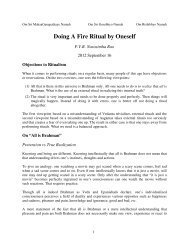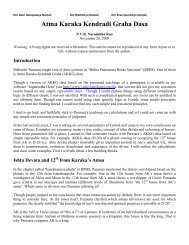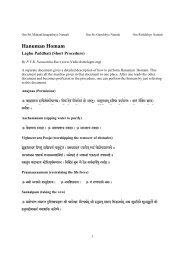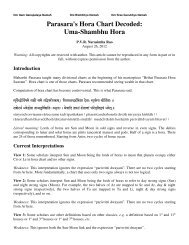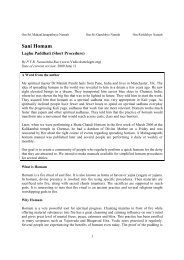The Glory of the Goddess-Devi Mahatmyam
The Glory of the Goddess-Devi Mahatmyam
The Glory of the Goddess-Devi Mahatmyam
You also want an ePaper? Increase the reach of your titles
YUMPU automatically turns print PDFs into web optimized ePapers that Google loves.
words used, cross-scriptural references, oral teaching from <strong>the</strong> Guru, various commentaries<br />
and finally <strong>the</strong> inner experiences that a practitioner goes through, all <strong>the</strong>se provide more<br />
authority to <strong>the</strong> esoteric interpretation. Interestingly all <strong>the</strong>se approaches are in harmony and<br />
point to a nearly precise esoteric meaning <strong>of</strong> <strong>the</strong> <strong>Devi</strong> <strong>Mahatmyam</strong>. Some writers have<br />
interpreted <strong>the</strong> demons and o<strong>the</strong>r allegories arbitrarily. But as affirmed here <strong>the</strong> interpretation<br />
cannot be loose or arbitrary and has to harmonise all <strong>the</strong> five approaches delineated above. It<br />
is not enough if an allegory makes spiritual or psychological sense if it is not etymologically<br />
in line. Nirukta too must agree. This is <strong>the</strong> approach used consistently in this book. For<br />
instance let us examine <strong>the</strong> esoteric interpretation <strong>of</strong> Madhu-Kaitabha. Honey is sweet. It is<br />
heavy. Any sweet in less quantity is sattvic, but in excess it is tamasic and <strong>the</strong>reby dangerous.<br />
Madhu is thus potentially tamasic. <strong>The</strong> insect (Kaitabha) is famous for its busyness. “Busy as<br />
a bee” is a common expression. Busyness is inherent to rajas. Thus Kaitabha is rajas. As one<br />
can see <strong>the</strong> etymological interpretation is in line with <strong>the</strong> cross-scriptural references from <strong>the</strong><br />
Mahabharata that clearly equate Madhu and Kaitabha with tamas and rajas. Of course <strong>the</strong><br />
psycho-spiritual interpretation too fits very well with <strong>the</strong> creation myth <strong>of</strong> Madhu-Kaitabha<br />
and Brahma.<br />
Second Episode-Mahishasuramardhini myth<br />
This is <strong>the</strong> second episode where <strong>the</strong> same Adi Sakti manifests Herself as Durga and<br />
overcomes Mahishasura <strong>the</strong> buffalo headed demon who is half human and half beast. <strong>The</strong><br />
demon is partly a pasu (animal or beast) and partly a human and thus has <strong>the</strong> dangerous<br />
ability to disrupt cosmic order and harmony. Overcoming this powerful combination <strong>of</strong><br />
beastly nature and human competence requires a fiery and dynamic form <strong>of</strong> Shakti, one that<br />
can combat worldly rajas through divine rajas.<br />
Technically <strong>the</strong> Primal form <strong>of</strong> <strong>the</strong> Mo<strong>the</strong>r that presides over Rajas is referred to as Maha<br />
Lakshmi whose coral complexion identifies Her clearly as <strong>the</strong> <strong>Devi</strong>’s Rajasic vyashti.<br />
Mahishasura too is <strong>the</strong> epitome <strong>of</strong> Rajas. But unlike <strong>the</strong> <strong>Devi</strong>’s divine rajas, Mahishasura’s<br />
rajas is <strong>of</strong> a negative nature. His rajasic energy controls him and impels him to destructive<br />
acts, whereas Durga controls her own fiery splendor. She is an embodiment <strong>of</strong> <strong>the</strong> wrath <strong>of</strong><br />
all <strong>the</strong> gods. Her rajas is protective <strong>of</strong> her devotees and intent on destroying evil. Her anger is<br />
divine anger that fights <strong>the</strong> demons.<br />
Of <strong>the</strong> three gunas only Rajas has two faces or two dimensions to it. One is a purely negative<br />
and gross expression that seeks material pleasures while <strong>the</strong> o<strong>the</strong>r is a divine and subtle<br />
expression that takes <strong>the</strong> individual inward, closer to <strong>the</strong> Supreme Being. Both are goal<br />
oriented except that demoniac rajas seeks only kama (desire or craving) and artha (material<br />
prosperity) while divine rajas seeks <strong>the</strong> fulfilment <strong>of</strong> righteous desires, all round divine<br />
prosperity and eventually moksha (<strong>the</strong> reference here is to <strong>the</strong> four goals <strong>of</strong> life). This<br />
difference in <strong>the</strong> direction <strong>of</strong> focus or goal is <strong>the</strong> main difference between <strong>the</strong> two types <strong>of</strong><br />
rajas. Rajas can bridge Tamas and Sattva. Lower order Rajas is closer to Tamas, while<br />
higher order Rajas is closer to Sattva. Lower order Rajas serves <strong>the</strong> purpose <strong>of</strong> Tamas and is<br />
potentially in danger <strong>of</strong> pulling us into <strong>the</strong> quagmire <strong>of</strong> Tamas. Higher order Rajas serves <strong>the</strong><br />
purpose <strong>of</strong> enabling Sattvavajaya or enabling Sattva to take over <strong>the</strong> o<strong>the</strong>r gunas.<br />
32



